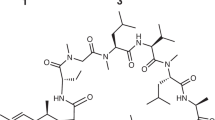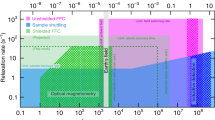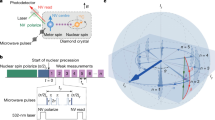Abstract
Nuclear magnetic resonance (NMR) in liquids and solids is primarily detected by recording the net dipolar magnetic field outside the spin-polarized sample. But the recorded bulk magnetic field itself provides only limited spatial or structural information about the sample. Most NMR applications rely therefore on more elaborate techniques such as magnetic field gradient encoding1 or spin correlation spectroscopy2, which enable spatially resolved imaging and molecular structure analysis, respectively. Here we demonstrate a fundamentally different and intrinsically information-richer modality of detecting NMR, based on the rotation of the polarization of a laser beam by the nuclear spins in a liquid sample. Optical NMR detection has in fact a long history in atomic vapours with narrow resonance lines3,4, but has so far only been applied to highly specialized condensed matter systems such as quantum dots5. It has been predicted6 that laser illumination can shift NMR frequencies and thus aid detection, but the effect is very small and has never been observed. In contrast, our measurements on water and liquid 129Xe show that the complementary effect—the rotation of light polarization by nuclear spins—is readily measurable, and that it is enhanced dramatically in samples containing heavy nuclei. This approach to optical NMR detection should allow correlated optical and NMR spectroscopy on complex molecules, and continuous two-dimensional imaging of nuclear magnetization with spatial resolution limited only by light diffraction.
This is a preview of subscription content, access via your institution
Access options
Subscribe to this journal
Receive 51 print issues and online access
$199.00 per year
only $3.90 per issue
Buy this article
- Purchase on Springer Link
- Instant access to full article PDF
Prices may be subject to local taxes which are calculated during checkout



Similar content being viewed by others
References
Lauterbur, P. C. Image formation by induced local interactions—examples employing nuclear magnetic resonance. Nature 242, 190–191 (1973)
Aue, W. P., Bartholdi, E. & Ernst, R. R. Two-dimensional spectroscopy—application to nuclear magnetic resonance. J. Chem. Phys. 64, 2229–2246 (1976)
Manuel, J. & Cohen-Tannoudji, C. Optical detection of magnetic resonance by modulation of paramagnetic Faraday effect transverse to Larmor frequency. Compt. Rend. 257, 413–416 (1963)
Romalis, M. V., Griffith, W. C., Jacobs, J. P. & Fortson, E. N. New limit on the permanent electric dipole moment of 199Hg. Phys. Rev. Lett. 86, 2505–2508 (2001)
Kikkawa, J. M. & Awschalom, D. D. All-optical magnetic resonance in semiconductors. Science 287, 473–476 (2000)
Buckingham, A. D. & Parlett, L. C. High-resolution nuclear magnetic resonance spectroscopy in a circularly polarized laser beam. Science 264, 1748–1750 (1994)
Evans, M. W. Optical phase conjugation in nuclear magnetic resonance: Laser NMR spectroscopy. J. Phys. Chem. 95, 2256–2260 (1991)
Warren, W. S., Mayr, S., Goswami, D. & West, A. P. Jr Laser-enhanced NMR spectroscopy. Science 255, 1683–1685 (1992)
Warren, W. S., Goswami, D. & Mayr, S. Laser enhanced NMR spectroscopy, revisited. Mol. Phys. 93, 371–375 (1998)
Harris, R. A. & Tinoco, I. Laser-perturbed nuclear magnetic resonance spectroscopy and the conservation of parity. J. Chem. Phys. 101, 9289–9294 (1994)
Buckingham, A. D. & Parlett, L. C. The effect of circularly polarized light on NMR spectra. Mol. Phys. 91, 805–813 (1997)
Jaszuński, M. & Rizzo, A. A study of the effect of circularly polarized light on NMR spectra and related properties of CS2 . Mol. Phys. 96, 855–861 (1999)
Li, L., He, T., Chen, D., Wang, X. & Liu, F.-C. Laser-induced NMR shift for Hg199 atom. J. Phys. Chem. A 102, 10385–10390 (1998)
Romero, R. H. & Vaara, J. Laser-induced splittings in the nuclear magnetic resonance spectra of the rare gas atoms. Chem. Phys. Lett. 400, 226–230 (2004)
Van der Ziel, P., Pershan, P. S. & Malmstrom, L. D. Optically-induced magnetization resulting from inverse Faraday effect. Phys. Rev. Lett. 15, 190–193 (1965)
Ledbetter, M. P. & Romalis, M. V. Nonlinear effects from dipolar interactions in hyperpolarized liquid 129Xe. Phys. Rev. Lett. 89, 287601 (2002)
Happer, W. & Mathur, B. S. Effective operator formalism in optical pumping. Phys. Rev. 163, 12–25 (1967)
Buckingham, A. D. Permanent and induced molecular moments and long-range intermolecular forces. Adv. Chem. Phys. 12, 107–142 (1967)
Barron, L. D. Molecular Light Scattering and Optical Activity (Cambridge Univ. Press, New York, 1982)
Driehuys, B. et al. High-volume production of laser-polarized 129Xe. Appl. Phys. Lett. 69, 1668–1670 (1996)
Zavattini, E. et al. Experimental observation of optical rotation generated in vacuum by a magnetic field. Phys. Rev. Lett. 96, 110406 (2006)
Ingersoll, L. R. & Liebenberg, D. H. Faraday effect in gases and vapors. II. J. Opt. Soc. Am. 46, 538–542 (1956)
Luc-Koenig, E. A priori study of the influence of relativistic effects on the hyperfine structure of 129Xe and 131Xe. J. Phys. E 33, 847–852 (1972)
Yoshino, K. & Freeman, D. E. Absorption spectrum of xenon in the vacuum-ultraviolet region. J. Opt. Soc. Am. B 2, 1268–1274 (1985)
Schaefer, S. R. et al. Frequency shifts of the magnetic-resonance spectrum of mixtures of nuclear spin-polarized noble gases and vapors of spin-polarized alkali-metal atoms. Phys. Rev. A 39, 5613–5623 (1989)
Xu, S., Sha, G. & Xie, J. Cavity ring-down spectroscopy in the liquid phase. Rev. Sci. Instrum. 73, 255–258 (2002)
Fini, J. M. Microstructure fibres for optical sensing in gases and liquids. Meas. Sci. Technol. 15, 1120–1128 (2004)
Cox, F. M., Argyros, A. & Large, M. C. J. Liquid-filled hollow core microstructured polymer optical fiber. Opt. Expr. 14, 4135–4140 (2006)
Maystre, F. & Bertholds, A. Magneto-optic current sensor using a helical-fiber Fabry-Perot resonator. Opt. Lett. 14, 587–589 (1989)
Olson, D. L., Peck, T. L., Webb, A. G., Magin, R. L. & Sweedler, J. V. High-resolution microcoil 1H-NMR for mass-limited, nanoliter-volume samples. Science 270, 1967–1970 (1995)
Acknowledgements
This work was supported by the US DOE and the US NSF. We thank W. Happer's group for use of the 9 T superconducting magnet and S. Smullin for comments on the manuscript.
Author information
Authors and Affiliations
Corresponding author
Ethics declarations
Competing interests
Reprints and permissions information is available at www.nature.com/reprints. The authors declare no competing financial interests.
Rights and permissions
About this article
Cite this article
Savukov, I., Lee, SK. & Romalis, M. Optical detection of liquid-state NMR. Nature 442, 1021–1024 (2006). https://doi.org/10.1038/nature05088
Received:
Accepted:
Issue Date:
DOI: https://doi.org/10.1038/nature05088
This article is cited by
-
Relation between molecular electronic structure and nuclear spin-induced circular dichroism
Scientific Reports (2017)
-
Multinuclear nanoliter one-dimensional and two-dimensional NMR spectroscopy with a single non-resonant microcoil
Nature Communications (2014)
-
The magic of solenoids
Nature (2007)
-
High-resolution, high-sensitivity NMR of nanolitre anisotropic samples by coil spinning
Nature (2007)
-
Shifting light with spin
Nature (2006)
Comments
By submitting a comment you agree to abide by our Terms and Community Guidelines. If you find something abusive or that does not comply with our terms or guidelines please flag it as inappropriate.



